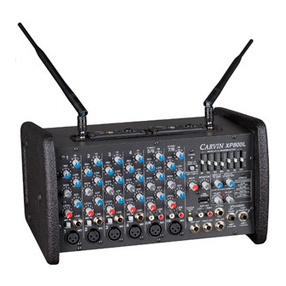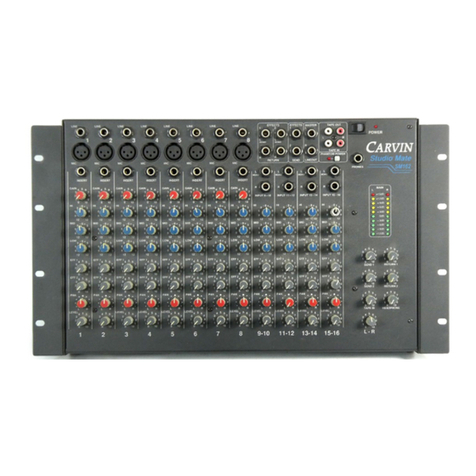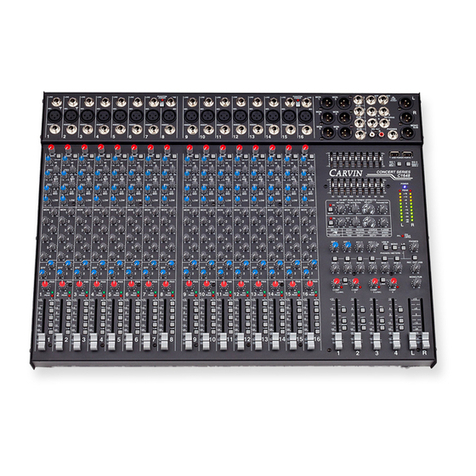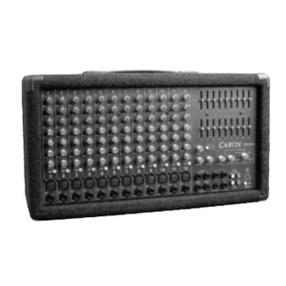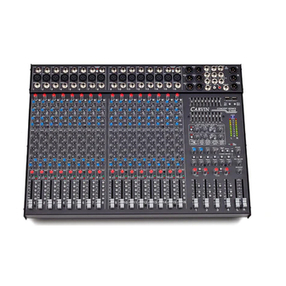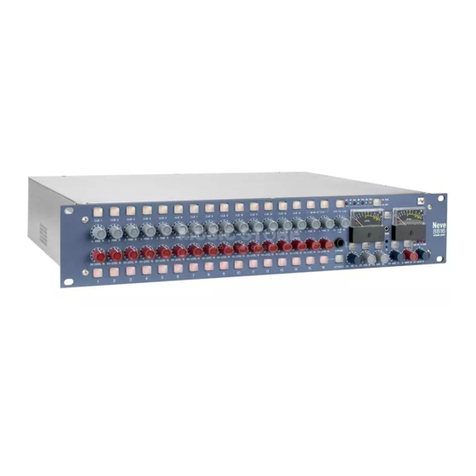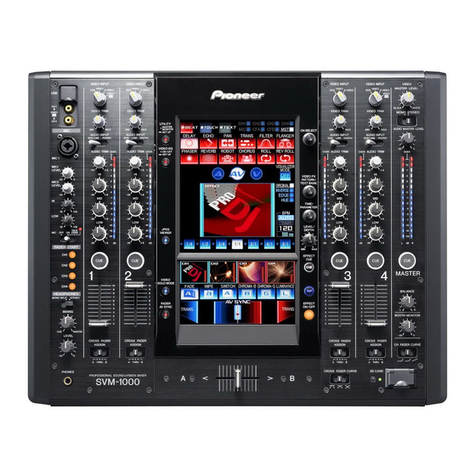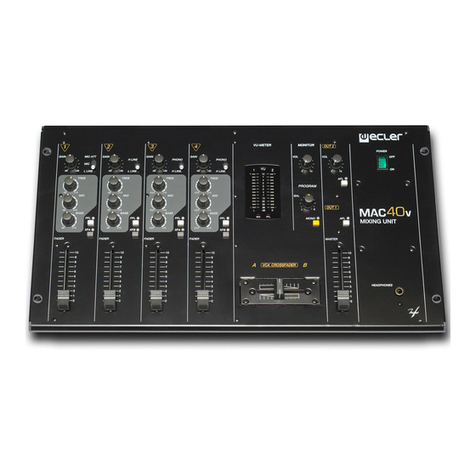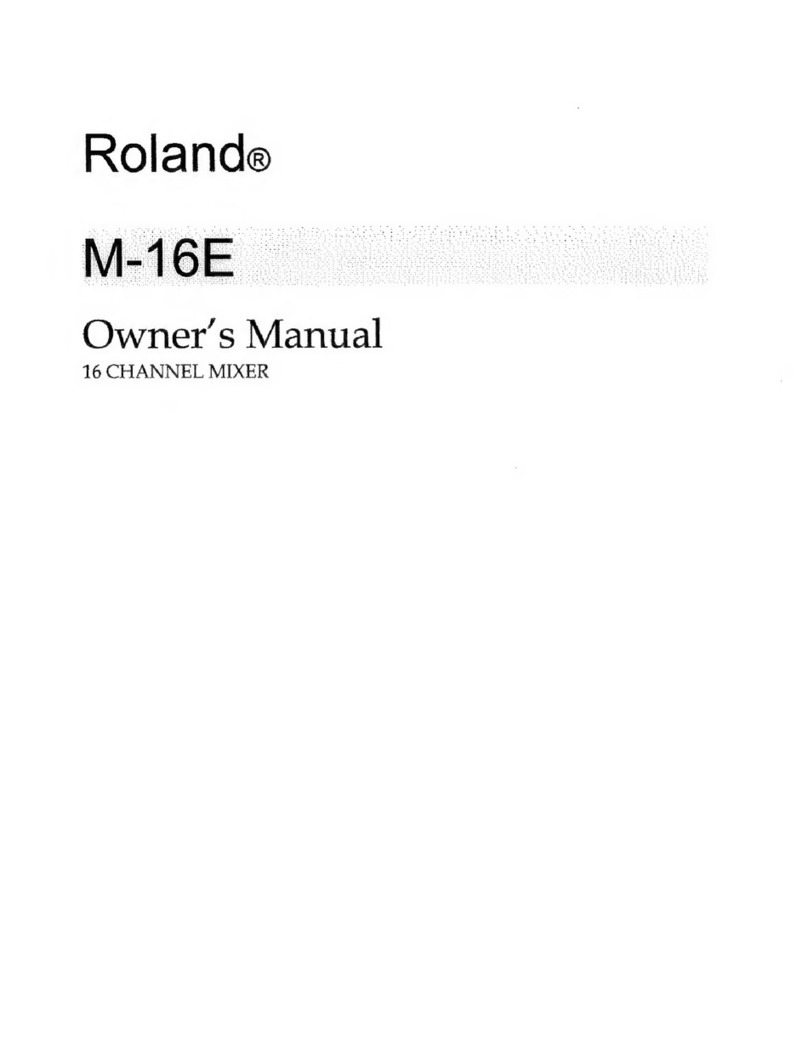QUICK START UP
If you’re like most new owners, you’re probably in a hurry to
plug your mixer in and use it. Here are some brief instruc-
tions to get you going quickly. With the mixer unplugged and
the unit turned off, complete the following procedures:
A. CONNECTING AC POWER TO YOUR MIXER
• Be sure to plug your mixer into the proper voltage for your
country, either 120V-60Hz or 240V-50Hz. The Pro-Mix 7
accepts both voltages listed.
• Use only a grounded (3 prong) power outlet to prevent a
shock hazard. This gives the quietest grounding for your
mixer.
B. CONNECTING INPUTS TO YOUR MIXER
• The RCA Phono inputs are for turntables ONLY!
• For CD players and similar devices, use the RCA LINE inputs.
Connecting other inputs will sound distorted.
• For balanced microphones, use a shielded cable and plug
into the XLR MIC inputs.
C. TURNING YOUR MIXER ON
•Set all channel and master LEVEL controls to their OFF
positions
•Set all HI, MID, and LOW controls to their center “flat -
no boost or cut” position.
• Turn the mixer on by the rear POWER SWITCH and watch
for the front POWER LED to come on. Your mixer is now
ready to operate by turning the levels up.
MIC CHANNEL
1. MIC GAIN CONTROL: The mic GAIN control
adjusts the level of the signal from the XLR and 1/4” MIC
input jacks. With the MIC LEVEL and MASTER controls at
“5” and the MIC switch “IN”, turn the GAIN control clock-
wise until the master METERS read about “0dB”. For an
average microphone, start with the GAIN at “5” and
increase. For other inputs such as a keyboard or sampler,
start with the GAIN at “2”. If the sound becomes distorted
or fuzzy, reduce this level until a clear signal is heard. When
this control is adjusted properly, it usually won’t need to be
adjusted for the remainder of the performance.
2. MIC TONE CONTROLS: Each MIC channel is
equipped with three tone controls: HI, MID, and LOW.
These are active EQ circuits that will boost or cut certain fre-
quencies of the MIC input by +or -15dB. The HI control
effects treble frequencies, peaking at 11.5kHz. The MID con-
trol effects mid-band frequencies, centered at 750Hz. The
LOW control adjusts bass frequencies, peaking at 80Hz.
3. MIC LEVEL CONTROL: This control adjusts the
level of the mic for mixing to the main output.
4. MIC ON SWITCH and LED: Pushing this switch
to the “IN” position will activate the MIC channel, allowing it
to be heard at the MASTER outputs. A lit LED shows the
channel is active.
5. TALKOVER SWITCH and LED: Pushing this
switch to the “IN” position lowers the level of music from
main channels 1-4, but leaves the microphone levels at nor-
mal. This will allow the MICS to be heard over the music
while making announcements, etc. A lit LED shows that
TALKOVER is active.
MAIN CHANNELS
6. LINE/PHONO SWITCH: This switch selects one
of two RCA inputs for the channel. It is also known as a
“TRANSFORM” switch. The “OUT” position selects the cor-
responding LINE input on channels 1-4. The “IN” position
selects the corresponding PHONO input on channels 1-3,
and LINE 5 input on channel 4.
7. GAIN CONTROL: For main channels 1-4
The channel GAIN control adjusts the level of the signal from the
selected LINE or PHONO input. If the sound becomes distorted
or fuzzy, reduce this level until a clear signal is heard. When this
control is adjusted properly, it usually won’t need to be adjusted
for the remainder of the performance. (see also #11)
8. CHANNEL TONE CONTROLS: Each of the main
channels are equipped with specialized tone controls: HI,
MID, and LOW. These are active EQ circuits that will boost
+15dB or cut -25dB. The accelerated cut of -25dB allows
you to “TURN DOWN” certain elements of a music track
until they are nearly inaudible. The HI control peaks
11.5kHz, affecting elements such as cymbals and bells. The
MID control is centered at 750Hz and affects elements such
as vocals and guitars. The
LOW control peaks at
80Hz and affects the BASS
elements of the music
track. If unusual distortion
is heard while adjusting
the tone controls, check
the channel LED METER,
and reduce the GAIN level
until the sound is clear
and the PK LED does not
light.
9. A/B CROSSFAD-
ER ASSIGNMENT
SWITCHES AND
LEDS: These switches
select on which side of the
CROSSFADER a channel
will be active. To hear a
channel at the MAIN OUT-
PUT, select A or B and
slide the CROSSFADER to
the appropriate side. The
“A” and “B” LEDs indicate
a channel has been
assigned. (see also #12.)
10. CHANNEL FADER:
These faders allow a mix
level to be set for a chan-
nel before the signal goes
to the CROSSFADER.
11. CHANNEL METER:
A Four LED meter meas-
ures the signal level of the
channel before the
CROSSFADER and after
the CHANNEL FADER.
• -12 dB indicates a
signal is present
• 0 dB indicates a
good signal level
• +12 dB indicates a
very strong signal
• PK indicates distor-
tion is present
If the red PK LED lights
up, reduce the level at the
GAIN control.
12. CROSSFADER: The CROSSFADER:adjusts the
mix of signal levels between “A” assigned channels and “B”
assigned channels, before they go to the MASTER fader.
(see #9) It can be used to transition from one song to the
next, or to blend sources during a performance. When the
crossfader is pushed all the way to the left “A” side, only
channels with a lit “A” LED will be heard. Moving the
CROSSFADER toward the center gradually blends together
both “A” and “B” channels. When the CROSSFADER is
pushed all the way to the right “B” side, only channels with
a lit “B” LED will be heard. The CROSSFADER also adjusts
signals going to the DIGITAL EFFECTS inputs A and B (see
#30). The CROSSFADER does not affect the level of the MIC
channels.
13. MASTER FADER: The MASTER fader adjusts the
overall output level of the mixer.
The level is changed at the following output jacks:
• RCA MASTER OUT
• RCA REC OUT
• XLR MASTER OUTPUTS L/R
• XLR MASTER OUTPUT MONO/SUB
(before MONO/SUB level control)
• 1/4” ZONE output -(MASTER selected as
SOURCE, before ZONE level)
• MONITOR and PHONES output
(MASTER mix only, before MONITOR LEVEL)
14. MONO SWITCH: The MONO switch combines the
right and left elements of the stereo signal. All LEFT and
RIGHT output signals will be identical. This feature is useful
when filling larger areas with music or when a stereo image
is not necessary.
15. MASTER METER LEDs: This group of LEDs is a
10 segment, 6dB resolution meter that monitors the LEFT
and RIGHT MASTER OUTPUT levels.
Be aware that some power amp/speaker systems, depend-
ing on how they are set, will be at FULL VOLUME when a
“0dB” level is reached. To prevent an accidental overload of
such a system, you may want to reduce all input GAIN con-
trols to compensate.
MONITOR SECTION
16. MONITOR MIX CONTROL: The mix control
adjusts the blend of what is heard at the monitor outputs.
When turned fully to the left, only the MASTER mix is heard.
When turned fully to the right, only the CUEs from the chan-
nels are heard. (see 17. & 18.) Any ratio of MASTER output
and CUE listening can be set by using this control.
17. CUE (1-4) SWITCHES: When pressed IN , these
switches allow you to listen to a source in the MONITOR
outputs without hearing it at the MAIN OUTPUTS. This will
allow you to set levels or find tracks before a channel is
assigned to the Aor Bside of the CROSSFADER.
18. CUE MICS SWITCH: Allows you to listen to the
MIC CHANNELS in the MONITOR outputs.
19. MONITOR LEVEL CONTROL: Adjusts the vol-
ume of the MONITOR mix heard at all MONITOR outputs:
PHONES (#20), MONITOR (PHONES)(#43) and MONITOR
(MONO)(#42).
20. PHONES JACK: Plug in your stereo headphones
here. A high output headphone amplifier will drive most any
headphone set.
AUX OUTPUT SECTION
21. MONO/SUB LEVEL CONTROL: Adjusts the
output level of the MONO/SUB XLR connector. Set this level
to where it sounds best with the MASTER OUTPUT speak-
ers. Then adjust the volume to all the speakers with the
MASTER FADER.
22. X-OVER SWITCH: When pressed IN, this switch
inserts a 3rd order crossover filter on the MONO/SUB XLR
output (#40), allowing only frequencies below 150 Hz to
pass through for subwoofer applications.
When used to run a SUBWOOFER (with power amp), this
allows more efficient use of power, resulting in a “tighter”
sounding bass response from the SUBWOOFER.
23. ZONE SOURCE SWITCH: When in the OUT
position, the ZONE output is the same as the MASTER out-
put. This is useful when
you need to control the
volume of music in a sep-
arate area. Set the ZONE
LEVEL to a desired vol-
ume and further control
with the MASTER FADER.
When pressed IN, the
ZONE jack becomes a sep-
arate output from the
MONITOR section. The
output level is NOT affect-
ed by the MONITOR
LEVEL control. Ideal when
an independent level con-
trol is needed for driving a
control room amp and
speaker.
24. ZONE LEVEL
CONTROL: Adjusts the
output level going to the
balanced ZONE 1/4” jack
(#41).
DIGITAL
EFFECTS
25. INPUT LEVEL
CONTROL: Adjusts the
level of signal going to the
processor.
26. PK / BYPASS
LED: If the LED consis-
tently flashes, it means the
INPUT LEVEL to the
processor is set too high,
causing distorted effects.
Reduce the INPUT LEVEL
until the LED lights only
occasionally or not at all.
A solid LED indicates the
processor is in bypass
mode and no effects will
be heard.
27. OUTPUT LEVEL:
Adjusts the volume of the
effects heard.
28. EFFECT SELEC-
TOR: To set the effects, turn the SELECT control to one of
four effect categories: ECHO, REVERB, CHORUS or FLANGE.
Turning the SELECT control within one of the four effects
regions will vary the intensity of each effect by changing the:
Regeneration of the DELAY, the high-frequency DAMPING of
the REVERB, the REVERB LEVEL in the CHORUS, or the
SPEED of the FLANGE.
29. PARAMETER ADJUSTS: The PARAMETER con-
trol changes the following on each effect: TIME of DELAY,
DECAY length of the REVERB, DEPTH of the CHORUS, or
DEPTH of the FLANGE.
30. PROCESS SWITCHES ( A, B, MICS 1-3 ):
These switches select which sources will be effected by the
processor. Pressing the A (or B) switch IN allows only sig-
nals from the A (or B) side of the CROSSFADER to be
processed. Pressing the MICS 1-3 switch allows MIC inputs
to be processed.
Stunning effects can be produced when manipulating the
CROSSFADER or PROCESS switches. A momentary burst
of sound will allow echo repeats or reverb tails to continue
after the original signal is removed.
31. BYPASS SWITCH: Turns off all effects as soon
as the switch is pressed in. The PK/BY LED lights when in
bypass mode.
32. POWER LED: Indicates the mixer is ON.
REAR PANEL
33. XLR MIC INPUT CONNECTORS: These bal-
anced Mic inputs are for connecting microphones that use
XLR connections. An additional MIC 1 input XLR is locat-
ed on the top panel for easy access and gooseneck mics.
34. 1/4" MIC INPUT JACKS: These input are for
connecting balanced and unbalanced microphones and
other sources such as drum machines etc.
35. GROUND LUG: Connect the ground wire from
your turntables here.
36. RCA LINE INPUTS (1-5): Use these inputs for
stereo sources such CD, MP3, MiniDisc, DAT, or other mixers.
37. RCA PHONO INPUTS (1-3): Use these inputs
for TURNTABLES ONLY. Other inputs will sound distorted
and may cause damage. These inputs feature RIAA equal-
ization filters, which is a standard for turntables.
38.MASTER OUT & REC OUT: Two RCA outputs
for connecting to power amps, other mixers or recorders
using RCA connectors.
39. RIGHT & LEFT MASTER OUTPUT BAL-
ANCED XLR CONNECTORS: Use these connectors
whenever possible to connect to power amps or other mix-
ers. The result is a 6dB hotter signal with the noise cancel-
lation of a balanced connection. Adjust output level at the
MASTER fader. (see #13.)
40. MONO/SUB BALANCED XLR CONNEC-
TOR: For connecting to Mono systems or to a SUB-
WOOFER AMP (see #22). Level is set at the MONO/SUB
level control and further adjusted at the MASTER FADER.
41. ZONE 1/4" OUTPUT JACK: A mono balanced
(or unbalanced ) output from the ZONE source. Using a
balanced (stereo) 1/4" cable will take advantage of the noise
cancellation of balanced 1/4" inputs on the power amp.
Recommended for long cable runs between the mixer and amp.
42. MONITOR 1/4" OUTPUT JACK (MONO):
Featuring a high output headphone amp, this jack is typi-
cally used for Mono headphones. It may also be used to
drive a power amp for the control room speaker.
43. MONITOR 1/4" OUTPUT JACK (PHONES):
Connect STEREO headphones here on the top panel or
both. Features a high output stereo headphone amp.
44. POWER SWITCH: Flip to the ON (up) position to
power up the mixer.
45. AC POWER RECEPTACLE: A detachable AC
cable is included. This mixer features a low-noise switch-
ing power supply that will run on any AC voltage from 90 to
255 VAC, 50-60Hz.
